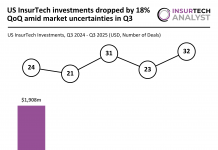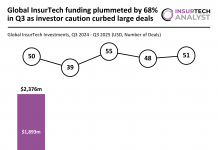Five Sigma has experienced a breakout year in 2025, with considerable demand for its AI and automation solutions for claims management.
The company’s multi-agent AI Claims Expert – Clive – works on top of any claims management system (CMS), accelerates claims handling and saves millions of dollars for insurers.
Clive was launched a year ago and today serves many carriers and TPAs worldwide, adding more use cases and functionality. Michael Krikheli, co-founder and CTO at Five Sigma, noted that the market has matured, with businesses moving from experimentation to seeking real ROI and production use cases. This shift has even prompted carriers and TPAs to rethink their technology strategies and consider replacing their current systems with an AI-native platform.
Why insurance AI projects usually flop
According to an MIT study, many insurance AI projects fail for three main reasons: a focus on demos over production readiness, a lack of specialized industry-specific solutions, and poor user experience and change management. The study found that fewer than 5% of AI initiatives actually make it to production.
Gil Nechushtai, chief product officer of Five Sigma, explained that many projects overestimate their readiness and underestimate the challenges of moving to a system in production. Demos of AI capabilities are relatively easy to create but getting them to work in a live operational environment is much different. This often stems from underestimating the complexities of change management and the quality of data.
A significant number of failed projects also rely on generic AI models that are not tailored to the specific needs of the insurance industry. Such needs include different lines of business, jurisdictions, and even organizations’ standard operating procedures (SOPs).
Another key issue is that user experience is not well thought out in advance. This leads to a disconnect where AI capabilities are difficult to integrate into existing systems and workflows, resulting in “AI silos” that are not useful.
Five Sigma navigates all these challenges successfully. The company specializes in claims, and develops AI and automation solutions that build on its expertise in this domain. It offers insurers and TPAs an integrated AI experience from both a platform and user experience perspective, with a change management approach that makes adoption of AI capabilities seamless, fast, and easy.
The role of Clive, the first AI Claims Expert
Clive is a multi-agent AI Claims Expert built specifically for the insurance industry. His design from the outset was to enable him (Five Sigma refers to him as a person, not a machine) to work seamlessly both within the Five Sigma claims management platform (CMS) and on top of any other CMS that an insurer is using. Clive’s infrastructure is built on Google’s Gemini LLM, Vertex AI, and Google Cloud, but also includes deep insurance domain knowledge, detailed agentic flows, and proprietary data modeling by Five Sigma’s team of insurance and tech gurus to bring everything together.
According to Krikheli, a key feature of Clive is the configuration layer for a company’s specific SOPs, which ensures that Clive is not only a claims expert, but also an expert for that particular insurer. This seamless integration into the workflow is what makes Clive unique.
The user experience is also a core part of Clive’s design, incorporating Explainable AI and enabling a human in the loop. Clive offers different modes of automation, from assisting users by providing recommendations as they make decisions, through working alongside them, to fully automating claims handling with Straight-ThroughProcessing (STP). An insurance company can select howit wants Clive to operate, depending on various claim parameters, or on its comfort with AI technology.
AI teamwork
Clive acts as an expert throughout the lifecycle of a claim. Clive’s multi-agent AI framework handles various adjustment and supervision tasks by using different AI agents for different tasks and stages. Clive’s AI agents can operate independently and are then orchestrated to move a claim forward. Claims stages, such as claim intake, triage, coverage decisions, and setting reserves, are broken down into a set of tasks, and then executed.
For example, “Clive™ Coverage” AI agent takes a coverage decision after reading the specific policy terms, understanding the incident description, and matching them with one another. “Each agent is a standalone unit but works collaboratively to handle claims tasks,” stresses Nechushtai. “The knowledge of these AI agents is like that of a claims adjuster or an entire claims team. The agents are connected to the relevant systems, draw the relevant information, and apply the correct analysis process to get to a decision.”
Five Sigma aims to meet customers where they are, acknowledging that some might find a complete AI overhaul too big a change. The company’s approach, supported by Clive’s infrastructure, allows customers to start with as little as one agent, build the integration, and expand as they go. This enables customers to get AI benefits fast and advance at their own pace, according to their organizational priorities and maturity.
Clive helps Claims Leaders Manage Claims Operations Better
Clive acts as an engine that understands both individual claims and the entirety of a claims portfolio, enabling him to answer questions and perform tasks throughout a claim’s lifecycle and as a supervisor across claims. According to Krikheli, this provides claims leaders with real-time operational visibility and performance KPIs at both the claim and the portfolio levels.
Clive does not simply wait for a question; it surfaces insights to highlight bottlenecks, at-risk claims, and compliance gaps. Additionally, leaders can use “Clive™ Inspection” AI agent to perform quality assurance and implement performance feedback loops to improve outcomes and ensure adherence to company SOPs and applicable regulation.
AI that Drives Tangible Results around the World
Insurers and TPAs using Clive have reported significant improvements and measurable results, including millions of dollars in savings from reduced mitigation costs, fines, and the need for expert analysis. Clive has been found to accelerate claim cycle time by 30%, and reduce (human) errors by 70%. These gains are a direct result of Clive’s AI agents handling repetitive tasks, allowing adjusters to focus on more valuable work.
Beyond financial and efficiency gains, Clive also improves policyholder satisfaction through faster claim resolution and more proactive communication. From a leadership perspective, Clive provides greater operational control and visibility into claims portfolios, which also helps insurers prepare more effectively for audits. Ultimately, claims teams can handle a higher volume of claims without needing to increase their staff, a key benefit for scalability.
Easy Connectivity Expedites Deployment
From an integration perspective, Clive is exposed as a set of REST APIs. This is how Five Sigma integrates with its own Claims Management Platform, and it is just as easy to use Clive on top of any other claims management system.
As Krikheli outlines, different AI agents require different data and, therefore, different levels of integration. For example, a FNOL agent might need policy data from a policy administration system, while a Settlement or Payment decision agents might require access to all correspondence, emails, and internal notes related to a claim.
The level of integration can vary, with the insurance company choosing their desired level of AI and automation capabilities. This can range from a simpler setup where Clive provides a recommendation that a user manually implements, to a more native, embedded experience where Clive’s recommendations automatically trigger actions in the underlying systems. Through such modular integration philosophy, Five Sigma can deliver AI value in months, rather than years.
Looking into the Future of Claims AI
As Five Sigma looks toward the future, Nechushtai sees expansion in two dimensions: the product roadmap and the business side. The product roadmap involves expanding Clive to cover additional building blocks of claims handling across different lines of business, and driving more actionability and automation, at both the claim level and the portfolio level.
On the business side, the company is continuing its geographic expansion and industry partnerships to bring Clive to more customers in more regions around the world (Clive is currently deployed in the US, UK, Europe, and Australia). The company also moves to serving higher tiers of insurance carriers. Krikheli says that the adoption of AI will move fast over the next couple of years. With its existing technology and planned roadmap, Five Sigma positions itself as a driving force in insurance claims’ AI and automation.
Keep up with all the latest InsurTech news here
Copyright © 2025 InsurTech Analyst










